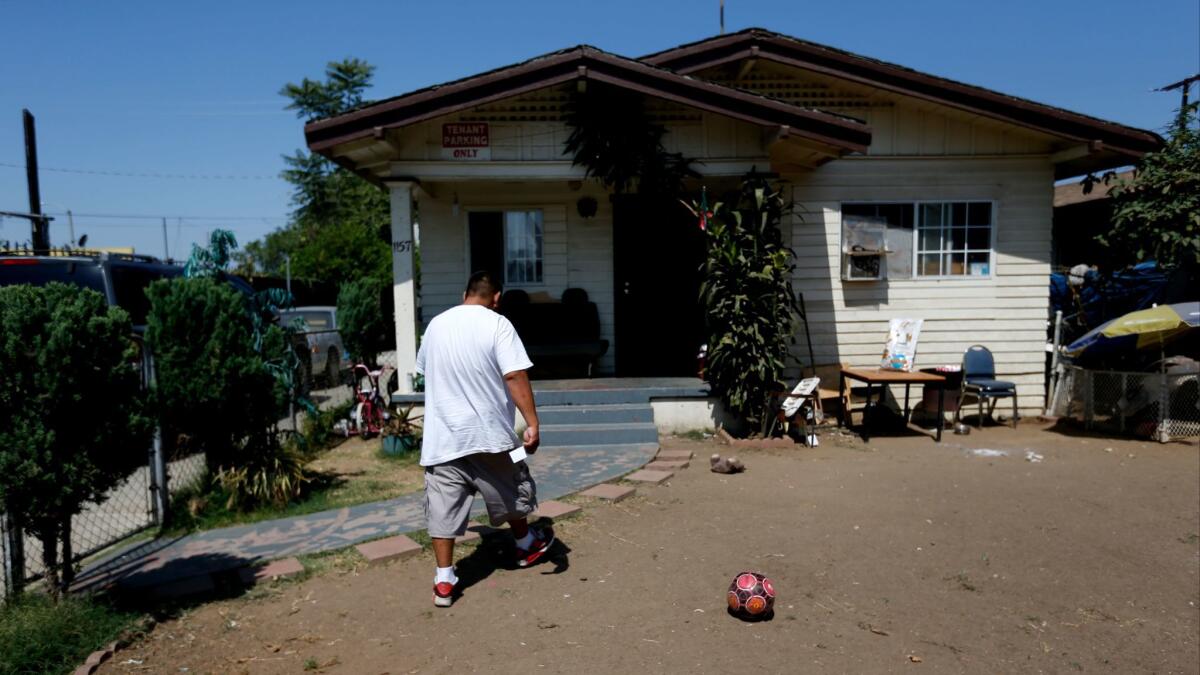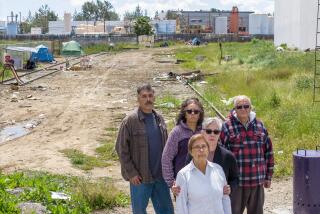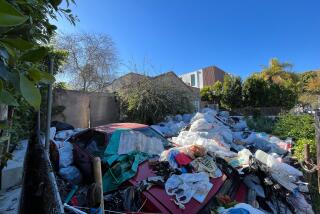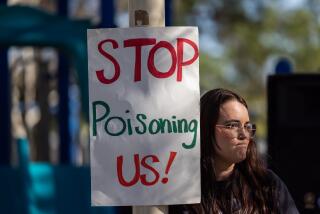Residents in ‘limbo’ as regulators delay cleaning any lead-tainted homes near Exide battery plant

The cleanup of thousands of lead-contaminated homes near a closed Vernon battery recycler has been at a standstill for months, with regulators arguing they cannot remove tainted soil from any properties until a yearlong environmental review is completed next summer.
But legal experts, county health officials and community groups say there is nothing preventing the California Department of Toxic Substances Control from acting immediately to remove hazardous levels of lead posing the highest risk of poisoning around the former Exide Technologies plant.
Testing by state regulators is finding elevated levels of lead in the soil at thousands of properties — more than authorities have money to clean. That is placing families across half a dozen southeast L.A. County neighborhoods in an uneasy position: learning that their homes are fouled with the poisonous metal but not knowing where they will rank on the priority list — and if their yards will be cleaned at all.
That uncertainty is trying the patience of Michelle Del Rio, who was informed by regulators in June that her family’s home in East Los Angeles had lead readings up to four times higher than federal standards allow. She wants to know why the authorities can’t clean her yard now.
“I’m stuck in this weird limbo where I may or may not get my soil cleaned,” Del Rio told officials at a public meeting this month. “Where does it end?”
We want to get the shovels in the ground; we want to get the cleanup moving.
— Barbara Lee, director of the state Department of Toxic Substances Control
The inaction renews questions about the urgency with which authorities are moving to protect people’s health in what will be the largest cleanup of its kind undertaken in California, spanning 10,000 residential properties as well as day cares, schools and parks.
Lead, a potent neurotoxin that spewed from the Exide facility for decades, is most harmful to young children who can ingest contaminated soil or dust. Even small amounts of lead can cause permanent learning and developmental deficiencies, lower IQs and behavioral problems.
State regulators say they are moving as quickly as they can and would act sooner if conditions at a property warrant immediate cleanup.
“We want to get the shovels in the ground; we want to get the cleanup moving,” toxic substances department Director Barbara Lee said in an interview. “Bear in mind we have a schedule in place to be undertaking cleanup this summer, so we’re talking about the difference of a few months at this point.”
Adding to residents’ anxiety are new records from the toxic substances department that indicate hundreds of homes with high lead contamination levels might not be cleaned after the state spends $176.6 million set aside by lawmakers for soil testing and remediation of properties near the plant. That pot of money will allow the state to remove lead from about 2,500 of those homes starting next summer, officials said.
Sampling results disclosed in a state cleanup plan this month suggest that almost 3,000 properties could surpass the federal cleanup level once all the parcels are tested.
Nearly 30% of homes tested through July exceed the federal health standard — 400 parts per million — considered hazardous in bare soil where children play, and more than 97% are above California’s more stringent cleanup standard of 80 ppm, the department found.
County officials and community groups are particularly concerned that cleanup has been delayed for homes with lead levels above 1,000 ppm — the state’s threshold for hazardous waste.
Soil sampling records obtained under the California Public Records Act show more than 200 residential properties tested through July had at least one lead reading above 1,000 ppm within 3 inches of the surface. And there are likely more; the department has released soil sampling records on less than half of the 5,800 parcels sampled so far.
The Los Angeles County Department of Public Health says the highest-risk properties with lead levels exceeding 1,000 ppm can and should be cleaned immediately.
You’ve got kids playing in toxic lead — one of the best-documented harmful chemicals out there.
— Richard Drury, environmental attorney
The environmental review “does not preclude government from taking immediate action to protect public health,” said Angelo Bellomo, a deputy director for the county health department. “These are physical conditions on a property that could dangerously expose children playing on the soil.”
Experts on the California Environmental Quality Act, which requires analysis of projects, agreed that the department could already be cleaning the worst-contaminated properties using one of several exemptions written into the law.
Douglas Carstens, a Hermosa Beach-based environmental attorney with no involvement in the Exide case, disputed the department’s contention that no cleanups can proceed amid the environmental review, characterizing the approach as a “drastic, all-or-nothing” position that “sounds to me more like bureaucratic reluctance.”
Using environmental review “as an excuse not to do anything,” said Carstens, “actually harms public health, and it’s a distortion and misuse of environmental law.”
When the Gov. Jerry Brown administration proposed spending $176.6 million for soil sampling and remediation earlier this year, it sought to exempt the entire cleanup from environmental review, arguing that by forgoing the analysis it would avoid another year of delay.
The administration backed down after objections from community and environmental groups who wanted to ensure officials would study and minimize the impacts of such a large-scale project and hold public meetings, among other transparency requirements. Brown signed the legislation in April.
But community groups critical of the pace of the project say they did not expect the department’s environmental review to halt cleanups of the most hazardous properties.
“It was not contemplated that the DTSC would cross its arms and refuse to exercise its authority to take emergency action,” said Gladys Limón, a staff attorney for Communities for a Better Environment.
Lee, director of the state toxics department, said the agency has looked into whether exemptions could be used on some properties, adding that they are not as straightforward as they sound and entail risk.
Richard Drury, an Oakland-based environmental attorney who is not involved in the Exide case, said it is unlikely that the use of emergency exemptions to expedite cleanup of highly contaminated properties would be successfully challenged in court.
“You’ve got kids playing in toxic lead — one of the best-documented harmful chemicals out there,” Drury said. “I don’t think there’s a judge in the state that would force DTSC to stop a cleanup when children’s health is in danger.”
The homes awaiting cleanup have lead concentrations as high as 45,600 ppm — more than 100 times the federal standard — according to the department’s recently released cleanup plan. Officials said the highest reading was found more than 3 inches below the surface on a single residential property but that its overall contamination level did not exceed the hazardous waste limit of 1,000 ppm.
The toxics department has previously disclosed a handful of cases where it conducted special cleanups of homes when parents disclosed high levels of lead in their children’s blood.
In a March report on speeding up its efforts near Exide, regulators argued that they could not complete cleanups using existing exemptions in state environmental law because “the levels of lead contamination are not considered an emergency.”
Lee said the state toxics department has not conducted emergency cleanups in the area and has no policy on what levels would trigger such actions. The department has the authority to respond quickly when there is an “imminent and substantial threat to the public,” but has not done so in communities near Exide, she said.
Residents in the working-class neighborhoods around the Exide plant are quick to contrast their situation to what happened recently in wealthier Porter Ranch, where a months-long gas leak triggered relocations and spurred Brown to declare a state of emergency.
It was not contemplated that the DTSC would cross its arms and refuse to exercise its authority to take emergency action.
— Gladys Limón, attorney for Communities for a Better Environment
Home remediation near Exide began in two small areas of Boyle Heights and Maywood in August 2014. A year later, regulators greatly expanded the cleanup zone after soil tests showed the plant’s lead emissions spread over an area of 10,000 homes.
Most of the 236 properties cleaned so far have been in the initial areas identified over three years ago. Completed more recently were cleanups of 50 homes with lead levels above 1,000 ppm using state funds approved in 2015. No homes have been cleaned since June, officials said.
Starting next summer, the state toxics department plans to clean at least 25 properties a week to complete 2,500 within two years, according to a report released this month. But the department is also studying a faster cleanup of 3,500 homes in the first year.
Additional cleanup funds anticipated from a new $1 fee on lead-acid batteries signed by Brown could help eventually but will take time to accumulate after the law takes effect in April.
The department plans to rank all properties near Exide using a formula that takes into account contamination levels, the presence of young children and other factors. According to its cleanup plan, each will be assigned a score indicating where it stands in line for cleanup “based on highest concentrations of lead and greatest potential risk.”
State Assemblyman Miguel Santiago (D-Los Angeles) said homes with the highest levels of lead, especially those with young children, should be cleaned immediately. He urged regulators “to find a legal way to do it when people’s health is in danger.”
Twitter: @tonybarboza
Twitter: @bposton
ALSO
The hunt for dollars to build the $64-billion bullet train
Chance of showers on Saturday, then dry, cloudy and cold on Christmas
Political Road Map: There’s a rich history of wanting to slice up California or split it off
More to Read
Start your day right
Sign up for Essential California for news, features and recommendations from the L.A. Times and beyond in your inbox six days a week.
You may occasionally receive promotional content from the Los Angeles Times.








